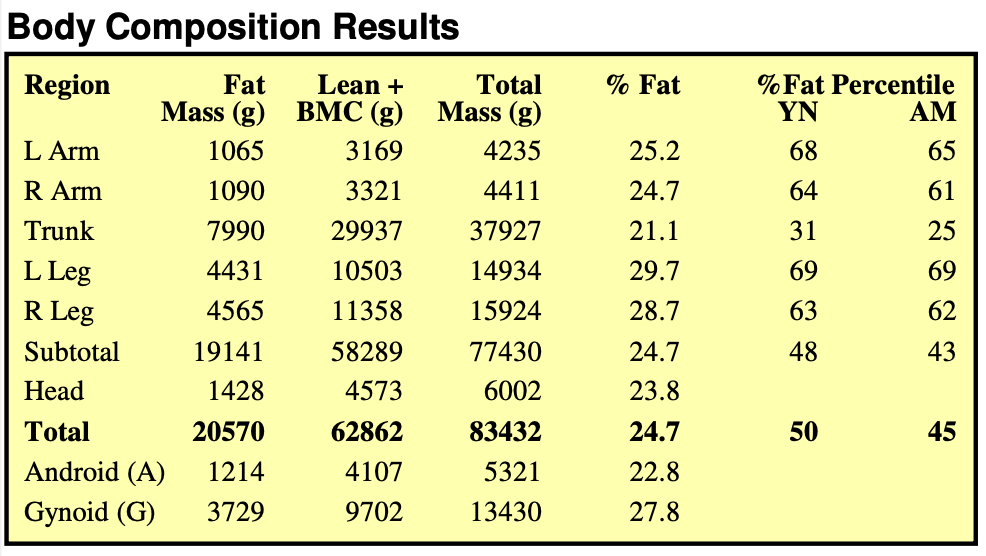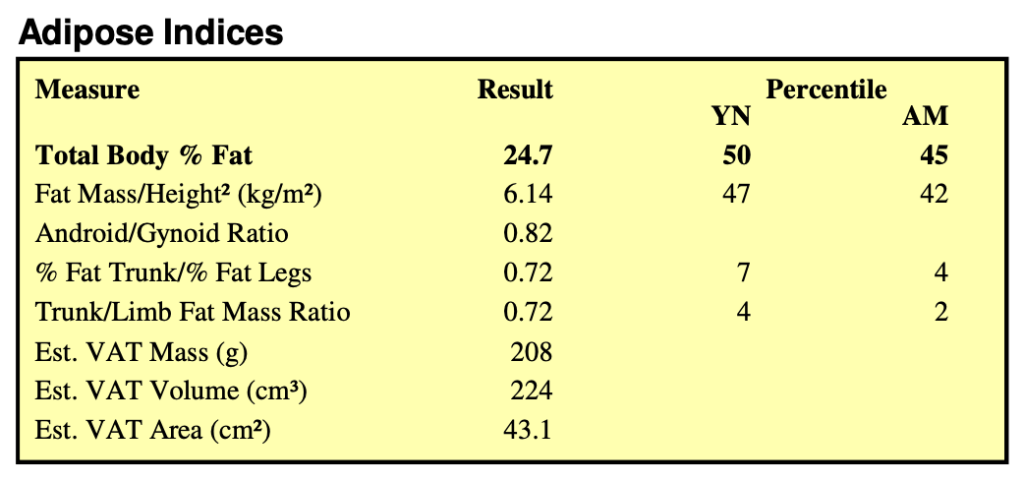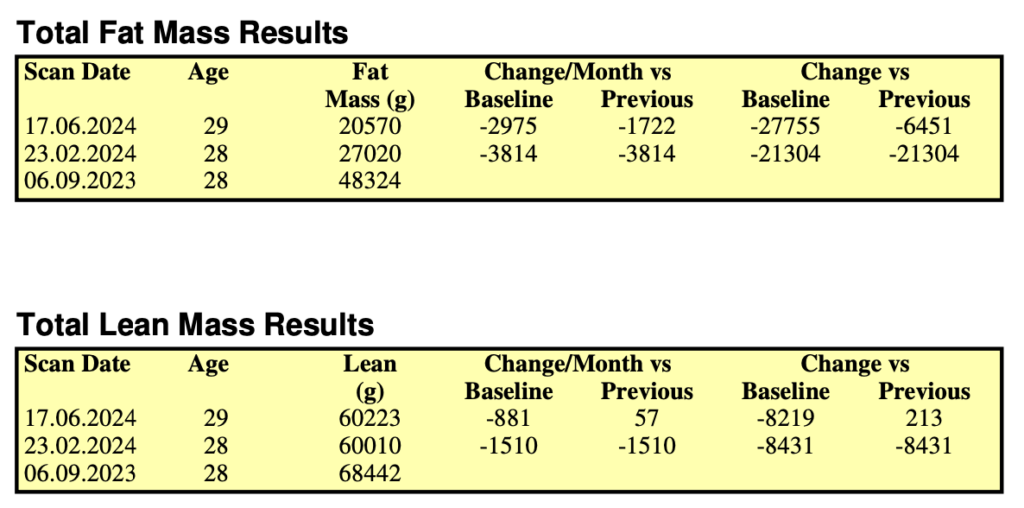
BLOG
Why are you not seeing results in the gym?

If you’ve been going to a gym for a year or more, next time you’re there look around and answer this question honestly: “How many of the people in your gym have actually changed body shape in the last 12 months?”
In other words, how many of your fellow gym-goers have noticeably lost fat or gained muscle or both? Who is in better shape?
Of course, not everyone does or should go to the gym to alter their shape. An improvement in cardiovascular fitness, strength or endurance may not cause, or require, a change in fat or muscle mass. But most Bodyscan customers book a DEXA scan to measure both of those and a determination to change one or both.
My own experience is that for all the hours of gym attendance, most gym-goers seem to be in exactly the same physical shape one, two, three years after they started.
Why is that? And isn’t that the definition of insanity? Repeating the same task with no noticeable outcome?
Here are my thoughts on why most gym-goers are getting bad (or no) results.
Fat Loss
- Exercise is a poor burner of fat
The fundamental principle of fat-loss is that you need to be in a sustained energy (calorie) deficit over time. That is, you need to consume fewer calories by way of the food and drink you consume than the calories you expend through physical activity/exercise and performing normal bodily functions.
That imbalance can be hard to achieve, let alone maintain because, in blunt simplistic terms, there are a high number of calories in food and drink and not very many in exercise. Consider that a premier league footballer may burn 1000 calories in a 90-minute match. That’s equivalent to a typical supermarket/take-away salad-plus-sandwich-plus-cappuccino lunch. Or 170g of peanuts.
In the gym, you’d have to jog on the treadmill for an hour to burn maybe 600 calories (the equivalent of a Pret ham and cheese sandwich).
Of course, a fat-loss strategy that includes exercise and activity is much better than one that doesn’t, but the best leverage is attained by focusing on the nutritional side of the energy equation. That’s because (willpower aside) it is far easier and quicker (immediate, in fact) to not eat 600 calories than it is to consume them and burn them off later. Also, the former puts you into an immediate deficit (a minus) while the latter leaves you back at zero.
Before you even go to the gym, a DEXA body composition scan will tell you exactly how much fat you have now and therefore how much would be advisable or desirable to lose. A DEXA scan presents your fat data in three precise metrics:
• total fat mass (in kilograms) – 20.57kg in the table below
• body fat percentage (the proportion of you that is fat) – 24.7% in the table below
• fat mass index (FMI) – see second table

Fat mass index is the most meaningful because it is not affected by your muscle mass (as is BF%) and it is normalised for your height – a tall person would typically carry more mass than a shorter one.

Only a DEXA scan can accurately and reliably give your FMI because it is the most consistent method for measuring total fat mass. In the table above, this man’s FMI is 6.14 equal to his total fat mass of 20.57kg divided by his height (in metres) squared.
A healthy FMI for most people might be between 5.5 and 7.0 for women, and 4.0 and 5.5 for men.
Bodyscan’s more than 21,000 DEXA scans show that consistently keeping average calorie consumption below maintenance achieves the best results for fat loss.
- You don’t exercise often enough
While a single burst of activity doesn’t create much of a dent on the calorie-burn side of the equation, regular sessions will have a cumulative effect and make more headway.
For example, if we say that 10,000 steps burns, say, 300 calories, that is the equivalent of just 50g of peanuts. Hardly seems worth it, does it?
But do your steps every day for a year and you could burn off 14kg (two stone) of body fat. Up your pace, include some hills and you’ll achieve more and sooner. It doesn’t have to be seven days a week, but four is better than one.
As part of your baseline DEXA scan consultation at Bodyscan, our body composition calculator will work out how many calories you burn. It does this reliably because the DEXA scan measures your total lean mass (muscle and organs), which is the biggest energy burner.
As above, the more frequently you exercise the more energy you will burn, and the DEXA calculator will factor this in.
Muscle building

- Muscle-building takes more effort than you think
Resistance training is good for us. It increases strength and helps us perform routine daily tasks from getting out of bed to carrying the groceries home. It also arrests the natural decline in muscle mass and bone density, which means we’re less likely to fracture a hip in older age.
But building muscle mass (physical size) takes hard work. There are men in my gym who “do weights” three times a week who are as skinny today as they were two years ago. Month after month they are not building any lean mass at all because they simply are not working hard enough.
Indeed, Bodyscan’s vast DEXA scan dataset shows muscle-building to be slow and most people have a very unrealistic expectation of how much muscle they will gain and the timeframe. It is harder for women to build mass and for everyone as we age.
A DEXA scan also provides the best metric for gauging existing muscle mass and setting a target – known as your lean mass index (LMI). Similar to FMI, this DEXA metric is your lean body mass (essentially muscle) in relation to your height.
Decades of research have shown a resistance training programme, optimised for volume and intensity, to be the most effective way to build muscle mass.
Volume means the number of times you lift a weight – that’s the total number of reps and sets (and therefore frequency of exercises/visits) you perform for each muscle group. Four sets of 12 reps is a 60% increase in volume over the usual three sets of ten.
Intensity means lifting a weight that is heavy enough to cause failure (where you cannot lift the weight for another rep) or near-failure at the chosen number of reps (eg, twelve).
Crucially, intensity also means pushing the weight up over time and this is where I think most people founder. ‘Progressive overload’ is essential, otherwise intensity remains the same and your muscles will not adapt (get bigger). If you are lifting the same weight for every exercise today as you were a month ago, then you are not gaining muscle mass.

A lot of (particularly) men seem to think that progressive overload means drastically ramping the weight up from one session to the next. But this alpha male, too-heavy-too-quick approach means they cannot achieve enough reps (volume) and their technique is so poor that they do not engage the muscles the exercise is designed to build.
The report from each DEXA scan automatically plots changes in lean mass (and fat) since the previous scan. When muscle gain has not met expectations, Bodyscan’s consultants will focus on how your programme might be optimised in terms of volume, intensity and technique.
- Muscle building requires fuel and octane
Skinny weight-trainers remain skinny because they disregard the same Newtonian principle responsible for fat loss. Reduction in body mass requires an energy deficit. An increase in weight (whether from fat mass or muscle mass) requires a surplus.
If your weight stays the same then you are ‘at maintenance’ – neither in surplus nor deficit. The quality of your training programme (volume, intensity, technique, rest periods) and your genetics will dictate how much of any surplus translates into muscle mass, but a surplus is essential to effect an increase in body weight.
If calories are the fuel, then protein can be considered the octane level. You’ve heard it many times before: protein is the ‘building block’ of muscle and without enough of it, muscle gain will not occur.
In summary, to give yourself the best chance of building muscle mass with minimal fat gain, you need: a small (maybe 200-400) calorie surplus; sufficient protein intake (2g per kilo of body weight is a good starting place); and a weights programme that includes intensity and volume (and, by implication, frequency).
- Muscle-building takes focus
This one is my biggest gym bugbear: it’s all the people (always men!) who spend more time on their phone or chatting or back-slapping with their fellow bros than they do on their routine. You will never – ever – build muscle if you treat the gym as a place to chat, meet your mates, create a playlist and check out Instagram.

I think I can say that, without exception, all the men and women building most muscle at my gym are there on their own. No distractions, no messaging, no chit-chat – they focus on their workout and then leave. Job done, results achieved. Focus on the job in hand and leave your phone in your locker!
How can a DEXA scan help you with fat loss and muscle gain?
For starters, a DEXA scan provides you with a comprehensive look at your body composition – fat, lean (muscle) and bone mass and visceral fat. From there, the DEXA scan data will provide you with specific, achievable targets as well as the nutritional energy requirements required and a realistic timeline.
Subsequent DEXA scans show your progress in terms of fat loss and muscle gain. Fat loss is nearly always achieved quicker than muscle gain and in a fat-to-lean ratio typically of 3:1 or 4:1.

The best first step you can make if you want to change your body composition is a DEXA body scan. Book yours at Bodyscan now.
Philip Chant

